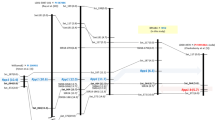Abstract
The objective of this study was to investigate the genetic mechanisms of soybean resistance to Asian rust (Phakopsora pachyrhizi Syd. & P. Syd). F2 and F3 generations from 15 diallel crosses involving six soybean cultivars, FT-2, EMBRAPA 48, BRS 154, BRS 184, BRS 214, BRS 231, were used to analyze the genetic control of Asian rust resistance in the soybean parents tested. Genetic models were fitted to means and variances of the generations tested in a completely randomized field experiment with 5,700 hill plots. The experiment was spray-inoculated twice with an isolate that was first detected during the 2002/03 season in Mato Grosso (MT) State and presently prevail in Central Brazil, at a six-day interval, on borders rows and on the useful area, respectively, with a 104 spores/ml distilled H2O suspension. Assessments were made using a diagrammatic scale for disease severity at seven and 39 days after the first detection of Asian rust in the experiments. Evaluations made in the second assessment (39 days) discriminated better between genotypes. Selection at early plant developmental stages may not result in adult resistant plants. Cultivar FT-2, which had presented monogenic resistance to a rust isolated that prevailed in the first two years of rust occurrence in Brazil, showed no resistance to the MT State rust strain used in this experiment, but eleven crosses showed genetic variability for resistance in the second assessment. Soybean rust resistant genes showing predominantly additive effects are dispersed among parents. Narrow sense heritability values ranging from 0.42 to 0.74 at the F3 family level in the second assessment suggested that selection of resistant genotypes is feasible.

Similar content being viewed by others
References
Brogin RL (2001) Controle genético da resistência da soja à mancha parda (Septoria glycines). Londrina: Universidade Estadual de Londrina. Dissertação de Mestrado, 87 pp
Canteri MG, Godoy CV (2003) Escala diagramática da ferrugem da soja (P. pachyrhizi). Summa Phytopathol 1:32
Fehr WR, Caviness CE (1981) Stage of soybean development. Iowa State University, Ames 12 pp (Iowa Cooperative Extensive Service. Special Report, 80)
Hartman GL, Bonde MR, Miles MM, Frederick RD (2004) Variation of Phakopsora pachyrhizi isolates on soybean. In: World Soybean Research Conference VII; IV International Soybean Processing and Utilization Conference; 30 Congresso Brasileiro de Soja. Proceedings
Hartwig EE (1995) Resistance to soybean rust. In: Proceedings of the soybean rust workshop. College of agricultural, consumer and environmental sciences, National Soybean Research Laboratory, Urbana, IL
Henning AA (2005) Manual de identificação de doenças de soja. In: Empresa Brasileira de Pesquisa Agropecuária. Documentos 256. Embrapa Soja, 72 pp
Jinks JL, Pooni HS (1976) Predicting the properties of recombinant inbred lines derived by single seed descendent. Heredity 36:253–266
Jinks JL, Pooni HS (1982) Predicting the properties of pure breeding lines extractable from a cross in the presence of linkage. Heredity 49:265–270
Mather K, Jinks JL (1982) Biometrical genetics, 3rd edn. Chapman and Hall, London, 396 pp
Miles MR, Frederick RD, Hartman GL (2006) Evaluation of soybean germplasm for resistance to Phakopsora pachyrhizi. Plant Health Progress (Available at: http://www.plantmanagementnetwork.org/php/elements/sum2.asp?id=5140)
Oliveira MF (1994) Análise e previsão do potential genético de um cruzamento do soja usando vários delineamentos em três épocas de semeadura. Londrina: Universidade Estadual de Londrina. Dissertação de Mestrado, 114 pp
Triller C, de Toledo JFF (1996) Using the F3 generation for predicting the breeding potential of soybean crosses. Braz J Genet 19:289–294
Yorinori JT, Nunes Júnior J, Lazzarotto JJ (2004) Ferrugem asiática da soja no Brasil: evolução, importância econômica e controle. In: Empresa Brasileira de Pesquisa Agropecuária. Documentos 247. Embrapa Soja, 36 pp
Acknowledgment
The authors thank CNPq and Instituto Interamericano de Cooperação para a Agricultura (IICA) for financial support.
Author information
Authors and Affiliations
Corresponding author
Rights and permissions
About this article
Cite this article
Ribeiro, A.S., Moreira, J.U.V., Pierozzi, P.H.B. et al. Genetic control of Asian rust in soybean. Euphytica 157, 15–25 (2007). https://doi.org/10.1007/s10681-007-9404-8
Received:
Accepted:
Published:
Issue Date:
DOI: https://doi.org/10.1007/s10681-007-9404-8




